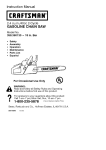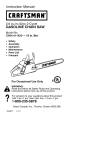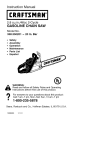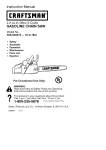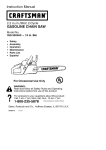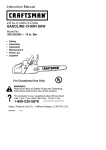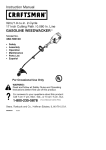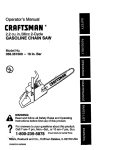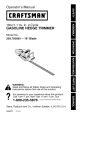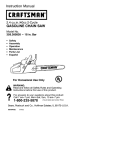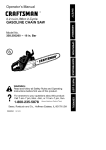Download Craftsman 358.360870 Instruction manual
Transcript
Instruction
Manual
I CRAFTSMAN°I
2.6 cu.in./42cc
GASOLINE
Model No.
358.360870
2-Cycle
CHAIN
SAW
- 18 in. Bar
Safety
Assembly
Operation
Maintenance
Parts List
Espar_ol
For Occasional
Use Only
WARNING:
Read and follow all Safety Rules and Operating
Instructions
before first use of this product.
For answers
Call 7 am-7
to your questions about this product:
pm, Mon-Sat;
Sun, 10 am-7 pm
1-800-235-5878
Sears, Roebuck
530163127
7/t0/02
and Co., Hoffman
(Hours
listed are Central Time)
Estates,
IL 60179 U.S.A.
Warranty
Safety Rules
Assembly
Operation
Maintenance
Service and Adjustments
2
2
6
7
13
17
FULL ONE YEAR WARRANTY
Storage
Troubleshooting
Table
Emissions Statement
Parts List
Spanish
Parts & Ordering
ON CRAFTSMAN
19
20
22
24
27
Back Cover
RGAS CHAIN SAW
For one year from the date of purchase, when this Craftsman Gas Chain Saw is
maintained, lubricated and tuned up according to the instruction manual, Sears
will repair, free of charge, any defect in material or workmanship.
This warranty excludes the bar, chain, spark plug and air filter, which are
expendable parts, and become worn during normal use.
If this Gas Chain Saw is used for commercial or rental purposes, this warranty
applies for 30 days from the date of purchase.
WARRANTY SERVICE IS AVAILABLE BY RETURNING THIS CHAIN SAW TO THE
NEAREST SEARS STORE OR SERVICE CENTER IN THE UNITED STATES.
This warranty gives you specific legal rights, and you may also have other rights
which vary from state to state.
Sears, Roebuck and Co., D/817 WA, Hoffman Estates, IL 60179
A
rot, WARNING:
Always disconnect
spark plug wire when making repairs
except for carburetor adjustments. Because a chain saw is a high-speed
woodcutting tool, special precautions
must be observed to reduce risk of accidents. Careless or improper use of
this tool can cause serious injury.
PLAN AHEAD
• Restrict tile use of your saw to adult
users who understand and can follow the safety rules, precautions,
and operating instructions found in
this manual.
Hearing
,_L_J
Protection _ _
Snug
I u'ur_-_
Pitting _--_, ,_
Safety Hat
Eye
Protection
Heavy Duty
Safety
Clothing'_T
Shoes _
Safety Chaps
Gloves
•
•
•
•
_
at_
•
• Wear protective gear. Always use
steel-toed safety footwear with non-slip
soles; snug-fitting clothing; heavy-duty,
2
non-slip gloves; eye protection such
as non-fogging, vented goggles or
face screen; an approved safety hard
hat; and sound barriers (ear plugs or
mufflers) to protect your hearing. Regular users should have hearing
checked regularly as chain saw noise
can damage hearing.
Secure hair above shoulder length. Do
not wear loose clothing or jewelry; they
can get caught in moving parts.
Keep all parts of your body away
from the chain when the engine is
running.
Keep children, bystanders, and animals at least 30 feet (10 meters)
away from the work area when starting and using the saw.
Do not handle or operate a chain saw
when you are fatigued, ill, or upset, or
if you have taken alcohol, drugs, or
medication. You must be in good
physical condition and mentally alert. If
you have any condition that might be
aggravated by strenuous work, check
with doctor before operating.
Do not start cutting until you have a
clear work area, secure footing, and
especially if you are felling a tree, a
retreat path.
OPERATE YOUR SAW SAFELY
• Do not operate with one hand. Serious injury to the operator, helpers, or
bystanders may result from onehanded operation. A chain saw is intended for two-handed use.
• Operate the chain saw only in a wellventilated outdoor area.
• Do not operate saw from a ladder or
in a tree.
• Make sure the chain will not make
contact with any object while starting
the engine. Never try to start the saw
when the guide bar is in a cut.
• Do not put pressure on the saw, especially at the end of the cut. Doing
so can cause you to lose control
when the cut is completed.
• Stop engine before setting saw down.
• Hand carry saw only when engine is
stopped. Carry with muffler away
from body; guide bar & chain projecting behind you; guide bar preferably
covered with a scabbard.
• Do not operate a chain saw that is
damaged, improperly adjusted, or not
completely and securely assembled.
Always replace bar, chain, hand
guard, chain brake, or other parts immediately if they become damaged,
broken, or are otherwise removed.
MAINTAIN
YOUR
SAW IN GOOD
WORKING ORDER
• Have all chain saw service performed by a qualified service dealer
except the items listed in the MAINTENANCE section of this manual.
• Make certain the saw chain stops
moving when the throttle trigger is
released. For correction, refer to
CARBURETOR ADJUSTMENTS.
• Keep the handles dry, clean, and
free from oil or fuel mixture.
• Keep caps and fasteners securely
tightened.
• Nonconforming replacement components or the removal of safety devices
may cause damage to the unit and
possible injury to the operator or bystanders. Use only Craftsman accessories and replacement parts as recommended. Never modify your saw.
• Maintain chain saw with care.
• Keep unit sharp and clean for better
and safer performance.
• Follow instructions for lubricating and
changing accessories.
• Check for damaged parts. Before further use of the chain saw, a guard or
other part that is damaged should be
carefully checked to determine that it
will operate properly and perform its
intended function. Check for alignment
of moving parts, binding of moving
parts, breakage of parts, mounting and
any other conditions that may affect its
operation. A guard or other part that is
damaged should be properly repaired
or replaced by a Sears Service Center
unless otherwise indicated elsewhere
in the instruction manual.
• When not in use, chain saws should
be stored in a dry, high or locked-up
place out of the reach of children.
• When storing saw, use a scabbard or
carrying case.
HANDLE FUEL WITH CAUTION
• Do not smoke while handling fuel or
while operating the saw.
• Eliminate all sources of sparks or
flame in areas where fuel is mixed or
poured.
• Mix and pour fuel in an outdoor area
and use an approved, marked container for all fuel purposes. Wipe up
all fuel spills before starting saw.
• Move at least 10 feet (3 meters) from
fueling site before starting.
• Turn the engine off and let saw cool
in a non-combustible
area, not on
dry leaves, straw, paper, etc. Slowly
remove fuel cap and refuel unit.
• Store the unit and fuel in a cool, dry
well ventilated space where fuel vapors cannot reach sparks or open
flames from water heaters, electric
motors or switches, furnaces, etc.
GUARD AGAINST KICKBACK
Follow all safety rules to help avoid
kickback and other forces which can
result in serious injury.
_,
Kickback Path
.t..- _
- ]:
Avoid Obstructions
Clear The Working
Area
A
411 WARNING:
Avoid kickback which
can result in serious injury. Kickback
is the backward, upward or sudden forward motion of the guide bar occurring
when the saw chain near the upper tip
of the guide bar contacts any object
such as a log or branch, or when the
wood closes in and pinches the saw
chain in the cut. Contacting a foreign
object in the wood can also result in
loss of chain saw control.
• Rotational
Kickback
can occur
when the moving chain contacts an
object at the upper tip of the guide
bar. This contact can cause the
chain to dig into the object, which
stops the chain for an instant. The
result is a lightning fast, reverse
reaction which kicks the guide bar up
and back toward the operator.
• Pinch-Kickback
can occur when the
the wood closes in and pinches the
moving saw chain in the cut along
the top of the guide bar and the saw
chain is suddenly stopped. This sudden stopping of the chain results in a
reversal of the chain force used to
cut wood and causes the saw to
move in the opposite direction of the
chain rotation. The saw is driven
straight back toward the operator.
• Pull-In can occur when the moving
chain contacts a foreign object in the
wood in the cut along the bottom of
the guide bar and the saw chain is
suddenly stopped. This sudden stopping pulls the saw forward and away
from the operator and could easily
cause the operator to lose control of
the saw.
REDUCE THE CHANCE OF
KICKBACK
• Recognize that kickback can happen.
With a basic understanding of kickback, you can reduce the element of
surprise which contributes to accidents.
• Never let the moving chain contact
any object at the tip of the guide bar.
• Keep working area free from obstructions such as other trees, branches,
rocks, fences, stumps, etc. Eliminate
or avoid any obstruction that your saw
chain could hit while cutting.
• When cutting a branch, do not let the
guide bar contact another branch or
other objects around it.
• Keep saw chain sharp and properly
tensioned. A loose or dull chain can
increase the chance of kickback. Follow manufacturer's chain sharpening
and maintenance instructions. Check
tension at regular intervals, but never
with engine running. Make sure chain
brake nuts are securely tightened.
• Begin and continue cutting at full
speed. If the chain is moving at a
slower speed, there is greater chance
of kickback occurring.
• Use extreme caution when reentering
a cut.
• Do not attempt cuts starting with the
tip of the bar (plunge cuts).
• Watch for shifting logs or other forces
that could close a cut and pinch or fall
into chain.
• Use the specified Reduced-Kickback
Guide Bar and Low-Kickback Chain.
Avoid Pinch-Kickback:
• Be extremely aware of situations or
obstructions that can cause material
to pinch the top of or otherwise stop
the chain.
• Do not cut more than one log at a
time.
• Do not twist saw as bar is withdrawn
from an undercut when bucking.
Avoid Pull-In:
• Always begin cutting with the engine
at full speed and the saw housing
against wood.
• Use wedges made of plastic or wood.
Never use metal to hold the cut open.
MAINTAIN CONTROL
Stand to the left of the saw
o
underside
Thumb on
,_
\!
Elbow
locked
Never reverse hand positions
• A good, firm grip on the saw with both
hands will help you maintain control.
Don't let go. Grip the rear handle with
your right hand whether you are right
or left handed. Wrap the fingers of
your left hand over and around the
front handlebar, and your left thumb
under the front handlebar. Keep your
left arm straight with the elbow locked.
• Position your left hand on the front
handlebar so it is in a straight line with
Low-Kickback Chain
yourrighthand
ontherearhandle
Contoured Depth Gauge
when
making
bucking
cuts.
Stand
slightly
totheleftsideofthesawto
deflects kickback
keep
yourbody
frombeing
inadirect
force and allows
linewiththecutting
chain.
_._,_
wood
longated
to gradually
Guard Link
• Stand
withyourweight
evenly
balride into Cutter
anced
onboth
feet.
• Donotoverreach.
Youcould
bedrawn CHAIN BRAKE
orthrown
offbalance
andlose
control. • Chain Brake: designed to stop the
chain in the event of kickback.
• Donot
c
ut
a
bove
shoulder
height.
difficult
tomaintain
control
ofsawItis
,_k WARNING:
WE DO NOT REPabove
shoulder
height.
KICKBACK
SAFETY FEATURES
RESENT AND YOU SHOULD NOT AS,_
WARNING:
The following features
are included on your saw to help reduce
hazard of kickback; however, such features will not totally eliminate this danger.
Do not rely only on safety devices. Follow all safety rules to help avoid kickback and other forces which can result
in serious injury,
• Front Hand Guard: designed to reduce
the chance of your left hand contacting the chain if your hand slips off the
front handlebar.
• Position of front and rear handlebars:
designed with distance between handles and "in-line" with each other. The
spread and "in-line" position of the
hands provided by this design work
together to give balance and resistance in controlling the pivot of the
saw back toward the operator if kickback occurs.
• Reduced-Kickback
Guide Bar: designed with a small radius tip which
reduces the size of the kickback danger zone on the bar tip. This type bar
has been demonstrated to significantly
reduce the number and seriousness of
kickbacks when tested in accordance
with ANS! B175.1.
_____&
Tip Guide Bar
Small Radius
Large
Radius
Tip Guide
Bar {_
• Low-Kickback Chain: has met kickback performance requirements when
tested on a representative sample of
chain saws below 3.8 cubic inch displacement specified in ANS! B175.1.
SUME THAT THE CHAIN BRAKE WiLL
PROTECT YOU IN THE EVENT OF A
KICKBACK. Kickback is a lightning fast
action which throws the bar and rotating chain back and up toward the operator. Kickback can be caused by allowing contact of the bar tip in the
danger zone with any hard object.
Kickback can also be caused by
pinching the saw chain along the top
of the guide bar. This action may push
the guide bar rapidly back toward the
operator. Either of these events may
cause you to lose control of the saw
which could result in serious injury or
even death. DO NOT RELY UPON ANY
OF THE DEVICES BUILT INTO YOUR
SAW. YOU SHOULD USE THE SAW
PROPERLY AND CAREFULLY TO AVOID
KICKBACK. Reduced-kickback
guide
bars and low-kickback
saw chains reduce the chance and magnitude of
kickback and are recommended.
Your
saw has a low kickback chain and bar
as original equipment.
Repairs on a
chain brake should be made by an authorized Sears Service Center. Take
your unit to the place of purchase orto
your nearest Sears Service Center.
• Tip contact in some cases may cause
a lightning fast reverse REACTION,
kicking guide bar up and back toward
operator.
• Pinching the saw chain along the top
of the guide bar may push the guide
bar rapidly back toward the operator.
• Either of these reactions may cause
you to lose control of the saw which
could result in serious injury. Do not
rely exclusively upon safety devices
built into your saw.
SAFETY
NOTICE:
Exposure
tovibra- SPARK ARRESTING SCREEN: Your
tions
through
prolonged
useofgasoline saw is equipped with a temperature limpowered
hand
tools
could
cause
blood iting muffler and spark arresting screen
vessel
ornerve
damage
inthefingers, which meets the requirements of Califorhands,
andjoints
ofpeople
prone
to
nia Codes 4442 and 4443. All U.S. forcirculation
disorders
orabnormal
swell- est land and the states of California, Idaing.Prolonged
useincold
weather
has ho, Maine, Minnesota, New Jersey,
beenlinked
toblood
vessel
damage
in Oregon, and Washington require by law
otherwise
healthy
people.
Ifsymptoms that
many internal combustion engines
occur
suchasnumbness,
pain,
lossof be equipped
with a spark arresting
strength,
change
inskincolor
ortexture, screen.
you operate a chain saw in a
orlossoffeeling
inthefingers,
hands,
or state or Iflocale
where such regulations
joints,
discontinue
the
useofthis
tool
exist, you are legally responsible for
andseek
medical
attention.
Ananti-vibration
system
does
notguarantee
the maintaining the operating condition of
these parts. Failure to do so is a violaavoidance
ofthese
problems.
Users
whooperate
power
toolsonacontinual tion of the law. Refer to Customer Reandregular
basis
must
closely
monitor sponsibilities chart in the MAINTENANCE
their
physical
andtheconditionsection.
ofthis
tool. condition
STANDARDS: This chain saw is listed
CHAIN
BRAKE:
Ifthissawistobe
by Underwriters Laboratories, Inc. in acused
forcommercial
logging,
achain
cordance with American National Stanbrake
isrequired
andshall
notberedards for Gasoline-Powered Chain
moved
orotherwise
disabled
tocomply Saws Safety Requirements (ANSI
withFederal
OSHA
Regulations
for
B175=1-2000).
Commercial
Logging.
,_ WARNING:
Before using chain
saw, ensure all fasteners are secure.
CARTON CONTENTS
Check carton contents against the following list.
Model 358.360870
• Chain Saw (fully assembled)
• Bar tool
• 2-cycle engine oil
• Carrying case
• Extra chain
• Gloves
• Bar and chain lube
Examine parts for damage. Do not use
damaged parts.
If you need assistance or find that parts
are missing or damaged, please call
1-800-235-5878.
NOTE: It is normal to hear the fuel filter
rattle in an empty fuel tank.
Your unit has been factory tested and
the carburetor precisely adjusted. As a
result you may smell gasoline or find a
drop of oil/fuel residue on the muffler
when you unpack the unit.
ASSEMBLY
Your saw is fully assembled;
assembly is necessary.
no
KNOW
YOUR
SAW
READ
THIS
INSTRUCTION
MANUAL
AND
SAFETY
RULES
BEFORE
OPERATING
YOUR
CHAIN
SAW.
Compare
theillustrations
withyourunittofamiliarize
yourself
with
thelocation
ofthevarious
controls
andadjustments.
Save
thismanual
forfuture
reference.
Chain Front
Hand
Guard
''-_r']] /_ _/.. Front Handle
Adjustment Tool
I II
/BarToo /
/_
I
_-
I: 1 I\.",
i
k_l
_
Chain
Muffler
Bar Oil Fill Cap
Cylinder
Fast Idle
_/
F/_
f
R
Starter Roe
_/_
P
ON/STOP
Switch
fb,I ILL--lb',.t^b,_./
Housing
Fuel Mix Fill Cap
Cover
Throttle
Lockout
Adjusting
Screw
Chain
Direction
of Travel
Chain Brake
_'
Sprocket
Chain
Nuts
Catcher
Hole
ON/STOP SWITCH
CHOKE KNOB
The CHOKE KNOB activates the choke to
The ON/STOP SWITCH is used to stop
the engine,
provide additional fuel to the engine durTHROTTLE TRIGGER
ing cold starting.
PRIMER BULB
The THRO]q-LE TRIGGER controls engine
Tile PRIMER BULB circulates fuel to the
speed,
THROTTLE LOCKOUT
carburetor to provide quicker starting.
The THRO3-I-LE LOCKOUT must be
CHAIN BRAKE
Tile CHAIN BRAKE is a device designed
pressed before you can squeeze the
to stop the chain if kickback occurs.
throttle trigger. This feature prevents you
The chain brake activates automatically
from accidentally squeezing the trigger.
in the event of kickback. The chain
FAST IDLE LOCK
Throttle
Trigger
Choke
Knob
Chain
Brake
The FAST iDLE LOCK holds the throttle
trigger in the starting position. Activate
the fast idle lock by pressing the throttle
lockout and squeezing the throttle trigger. With the throttle trigger squeezed,
press the fast idle lock. Release the
throttle lockout and trigger while holding
the fast idle lock button.
brake activates manually if the front
hand guard is pushed forward. The
chain brake is disengaged by pulling the
front hand guard back toward the front
handle as far as possible.
CHAIN TENSION
It is normal for a new chain to stretch
during first 15 minutes of operation. You
should check your chain tension frequently. See CHAIN TENSION under the
SERVICE AND ADJUSTMENTS section.
7
z_
Once oil is added to the gasoline,
_ WARNING:
Muffler
isveryhot
shake container momentarily to assure
during
andafteruse.Donottouch
the
the fuel is thoroughly mixed. Almuffler
orallow
combustible
material that
ways read and follow the safety rules
suchasdrygrass
orfueltodoso.
relating to fuel before fueling your unit.
BEFORE
STARTING
ENGINE
IMPORTANT
Experience indicates that alcohol
_ WARNING:
Besuretoread
the
blended fuels (called gasohol or using
fuelhandling
information
inthesafety ethanol or methanol) can attract moisrulessection
ofthismanual
before
you ture which leads to separation and
begin.
Ifyoudonotunderstand
the
formation of acids during storage. Acidic
fuelhandling
information
donotatgas can damage the fuel system of an
tempt
tofuelyourunit.Seek
helpfrom engine while in storage. To avoid engine
someone
thatdoesunderstand
thein- problems, the fuel system should be
formation
orcallthecustomer
assis- emptied before storage for 30 days or
tance
helplineat1-800-235-5878. longer. Drain the gas tank, start the enGUIDE
BARANDCHAIN
OIL
gine and let it run until the fuel lines and
Thebarandchain
require
lubrication. carburetor are empty. Use fresh fuel
Thechain
oilerprovides
continuous
lu- next season. See STORAGE instructions
brication
tothechain
andguide
bar.Be for additional information.
suretofillthebaroiltankwhen
youfill
Never use engine or carburetor cleanthefueltank(Capacity
=6.8ft.oz.).
er products in the fuel tank or permaLack
ofoilwillquickly
ruinthebarand nent damage may occur.
chain.
Toolittle
oilwillcause
overheat- See the STORAGE section for additional information.
ingshown
bysmoke
coming
from
the
chain
and/or
discoloration
ofthebar.
CHAIN BRAKE
Formaximum
guide
barandchain
life, Ensure chain brake is disengaged by
werecommend
youuseCraftsman pulling the front hand guard back tochain
sawbaroil.IfCraftsman
baroilis ward the front handle as far as posnotavailable,
youmayuseagood
sible. The chain brake must be disengrade
SAE
30oiluntil
youareableto
gaged before cutting with the saw.
obtain
Craftsman
brand.
Theoiloutput
is
automatically
metered
during
operation.,dl_ WARNING: The chain must not
Your
sawwilluseapproximately
one
when the engine runs at idle
tankofbaroilforevery
tankoffuelmix. move
speed. If the chain moves at idle
Always
fillthebaroiltankwhen
youfill speed, refer to CARBURETOR ADJUSTthefueltank.
MENT within this manual. Avoid conFUELING
ENGINE
tact with the muffler. A hot muffler can
cause serious burns.
_WARNING:Remove
fuelcap
STOPPING YOUR ENGINE
slowly
whenrefueling.
• Move ON/STOP switch to the STOP
Thisengine is certified to operate on
position.
unleaded gasoline. Before operation,
gasoline must be mixed with a good
quality synthetic 2-cycle air-cooled engine oil. We recommend Craftsman
brand synthetic oil. Mix gasoline and
oil at a ratio of 40:1. A 40:1 ratio is obtained by mixing 3.2 ounces of oil with
1 gallon of unleaded gasoline. Included with this saw is a 3.2 ounce
STARTING POSITION
• To start the engine, hold the saw
firmly on the ground as illustrated.
Make sure the chain is free to turn
without contacting any object.
Starter Rope Handle
Leff Hand
container of Craftsman brand synthetic
oil. Pour the entire contents of this
container into 1 gallon of gasoline to
achieve the proper fuel mixture.
DO NOT USE automotive oil or boat oil.
These oils will cause engine damage.
When mixing fuel, follow instructions
printed on the oil container.
on Front
Right'Foot
8
Through
Rear Handle
IMPORTANT POINTS TO REMEMBER
When pulling the starter rope, do not
use the full extent of the rope as this
can cause the rope to break. Do not
let starter rope snap back. Hold the
handle and let the rope rewind slowly.
NOTE: DO NOT attempt to cut material
with the fast idle lock button in the
locked position.
DIFFICULT STARTING (or starting a
flooded engine)
The engine may be flooded if it has not
started after 10 pulls.
Flooded engines can be cleared of excess fuel by following the warm engine
starting procedure listed above, insure
the ON/STOP switch is in the ON position.
Starting could require many pulls depending on how badly unit is flooded.
If engine still fails to start, refer to the
TROUBLESHOOTING TABLE or call
1-800-235-5878.
CHAIN BRAKE
STARTING A COLD ENGINE (or a
warm engine after running out of
fuel)
1. Move ON/STOP switch to ON position.
2. Pull choke knob out to the full extent.
3. Slowly press the primer bulb 6
times.
_lJ WARNING:
Primer Bulb
Switch
ON/STOP _"_"__,_
Choke _[-_-'
Knob
LJ
off
If tile brake band is
worn too thin it may break when the
chain brake is triggered. With a broken
brake band, the chain brake will not stop
the chain. The chain brake must be replaced if any part is worn to less than
0.020 inch (0.5 ram) thick. Repairs on a
chain brake should be made by your
Sears Service Center. Take your unit to
the place of purchase or to the nearest
Sears Service Center.
• This saw is equipped with a chain
brake. The brake is designed to stop
the chain if kickback occurs.
• The inertia-activated
chain brake is
activated if the front hand guard is
pushed forward, either manually (by
hand) or automatically (by sudden
movement).
• If the brake is already activated, it is
disengaged by pulling the front hand
guard back toward the front handle
as far as possible.
• When cutting with the saw, the chain
brake must be disengaged.
Disengaged _m,_.
!
_t__,
Full
4.
Squeeze and hold throttle trigger.
With thumb press fast idle lock
down; then release throttle trigger.
5. Sharply pull the starter rope handle
5 times with your right hand. Then,
proceed to the next step.
NOTE: If the engine sounds as if it is
trying to start before the 5th pull, stop
pulling and immediately proceed to the
next step.
6. Fully push in choke knob (to the
OFF position); pull the starter rope
until the engine starts.
7. Allow the engine to run for approximately 5 seconds. Then, squeeze
and release the throttle trigger to
allow engine to return to idle
speed.
STARTING A WARM ENGINE
1. Fully push in choke knob (to the
OFF position).
2. Move ON/STOP switch to ON position.
3. Slowly press primer bulb 6 times.
4. Squeeze and hold throttle trigger.
With thumb press fast idle lock
down; then release throttle trigger.
5. Sharply pull starter rope with your
right hand until the engine starts.
6. Squeeze and release the throttle
trigger to return engine to idle speed.
::
Engaged
Braking function control
CAUTION: The chain brake must be
checked several times daily. Tile engine
must be running when performing this
procedure. This is the only instance
when the saw should be placed on the
ground with the engine running.
Place the saw on firm ground. Grip the
rear handle with your right hand and
the front handle with your left hand.
Apply full throttle by fully depressing
the throttle trigger. Activate the chain
brake by turning your left wrist against
9
thehand
guard
without
releasing
your
griparound
thefront
handle.
Thechain
should
stopimmediately.
Inertia
activating function control
_ WARNING:
When performing the
following procedure, the engine must
be turned off.
Grip the rear handle with your right hand
and the front handle with your left hand.
Hold the chain saw approximately 14"
(35 cm) above a stump or other wooden
surface. Release your grip on the front
handle and let the tip of the guide bar
fall forward and contact the stump.
When the tip of the bar hits the stump,
the brake should activate.
OPERATING TIPS
• Check chain tension before first use
and after 1 minute of operation. See
CHAIN TENSION in the MAINTENANCE
section.
• Cut wood only. Do not cut metal,
plastics, masonry, non-wood building
materials, etc.
• Stop the saw if the chain strikes a
foreign object. Inspect the saw and
repair parts as necessary.
• Keep the chain out of dirt and sand.
Even a small amount of dirt will
quickly dull a chain and increase the
possibility of kickback.
• Practice cutting a few small logs using the following steps. This will help
you get the "feel" of using your saw
before you begin a major sawing operation.
• Squeeze the throttle trigger and allow the engine to reach full speed
before cutting.
• Begin cutting with the saw frame
against the log.
• Keep the engine at full speed the
entire time you are cutting.
• Allow the chain to cut for you. Exert
only light downward pressure.
• Release the throttle trigger as soon
as the cut is completed, allowing
the engine to idle. If you run the
saw at full throttle without a cutting
load, unnecessary wear can occur
to the chain, bar and engine. It is
recommended
that the engine
not be operated for longer than
30 seconds at full throttle.
• To avoid losing control when cut is
complete, do not put pressure on
saw at end of cut.
• Stop engine before setting saw down.
TREE FELLING
_& WARNING:
dead branches
TECHNIQUES
Check for broken or
which can fall while
cutting causing serious injury. Do not
cut near buildings or electrical wires if
you do not know the direction of tree
fall, nor cut at night since you will not
be able to see well, nor during bad
weather such as rain, snow, or strong
winds, etc. If the tree does make contact with any utility line, the utility company should be notified immediately.
• Carefully plan your sawing operation
in advance.
• Clear the work area. You need a
clear area all around the tree so you
can have secure footing.
• The chain saw operator should keep
on the uphill side of the terrain as the
tree is likely to roll or slide downhill
after it is felled.
• Study the natural conditions that can
cause the tree to fall in a particular
direction. These conditions include:
• The wind direction and speed.
• The lean of the tree. The lean of a
tree might not be apparent due to
uneven or sloping terrain. Use a
plumb or level to determine the direction of tree lean.
• Weight and branches on one side.
• Surrounding trees and obstacles.
• Look for decay and rot. If the trunk is
rotted, it can snap and fall toward the
operator.
• Make sure there is enough room for
the tree to fall. Maintain a distance of
2-1/2 tree lengths from the nearest
person or other objects. Engine
noise can drown out a warning call.
• Remove dirt, stones, loose bark,
nails, staples, and wire from the tree
where cuts are to be made.
_'_'e
;_....
Plan a clear retreat path
U"_"
Direction of fall
45 _ ./.,.
",.!,e¢
yie.6¢"
FELLING LARGE TREES
(6 inches in diameter or larger)
The notch method is used to fell large
trees. A notch is cut on the side of the
tree in the desired direction offaE After
a felling cut is made on the opposite
10
sideoftree,thetreewilltendtofallin
thedirection
ofthenotch.
NOTE:
Iftreehaslarge
buttress
roots,
remove
thembefore
making
thenotch.
Ifusing
sawtoremove
buttress
roots,
keepsawchain
fromcontacting
ground
toprevent
dulling
ofthechain.
NOTCH
CUTAND FELLING TREE
• Make notch cut by cutting tile top of
the notch first. Cut through 1/3 of the
diameter of the tree. Next complete
the notch by cutting the bottom. See
illustration. Once the notch is cut, remove the wedge of wood from tree.
Felling cut here
First cut
Seoo,?cJ
out_ _
}
=,.
j
':"..,.4,
,/
\
e
• After removing the wood from the
notch, make the felling cut on the opposite side of the notch. This is done
by making a cut about two inches
higher than the center of the notch.
This will leave enough uncut wood
between the felling cut and the notch
to form a hinge. This hinge will help
prevent the tree from falling in the
wrong direction.
Hinge holds tree on
stump and helps
control fall
Opening of
felling cut
Closing
of notch
NOTE: Before felling cut is complete,
use wedges to open the cut when
necessary to control the direction of
fall. To avoid kickback and chain
damage, use wood or plastic wedges,
but never steel or iron wedges.
• Be alert to signs that the tree is
ready to fall: cracking sounds, widening of the felling cut, or movement in
the upper branches.
• As tree starts to fall, stop saw, put it
down, and get away quickly on your
planned retreat path.
• DO NOT use your saw to cut down a
partially fallen tree. Be extremely
cautious with partially fallen trees
that may be poorly supported. When
a tree doesn't fall completely, set the
saw aside and pull down the tree
with a cable winch, block and tackle,
or tractor.
CUTTING A FALLEN TREE
(BUCKING)
Bucking is tile term used for cutting a
fallen tree to the desired log size.
_WARNING:
Do not stand on the
log being cut. Any portion can roll
causing loss of footing and control. Do
not stand downhill of the log being cut.
IMPORTANT POINTS
• Cut only one log at a time.
• Cut shattered wood very carefully;
sharp pieces of wood could be flung
toward operator.
• Use a sawhorse to cut small logs.
Never allow another person to hold
the log while cutting and never hold
the log with your leg or foot.
• Do not cut in an area where logs,
limbs, and roots are tangled. Drag logs
into a clear area before cutting them
by pulling out exposed and cleared
logs first.
TYPES OF CUTTING USED FOR
BUCKING
,_
WARNING:
If saw becomes
pinched or hung in a log, don't try to
force it out. You can lose control of the
saw resulting in injury and/or damage
to the saw. Stop the saw, drive a
wedge of plastic or wood into the cut
until the saw can be removed easily. Restart saw and carefully reenter the cut.
Do not use a metal wedge. Do not attempt to restart your saw when it is
pinched or hung in a log.
Use a wedge to remove pinched saw
Turn saw OFF and use a plastic or
wooden wedge to force cut open.
Overcutting
begins on the top side of
the log with the bottom of the saw
against the log. When overcutting use
light downward pressure.
11
1st Cut
_Overcuttingz;G_I_
_;_/
_-_-_" _
Undercutti_',_s
Undercutting involves cutting on the
underside of the log with top of saw
against the log. When undercutting
use light upward pressure. Hold saw
firmly and maintain control. The saw
will tend to push back toward you.
Using a support stand
/
WARNING:
Never turn saw upside down to undercut. The saw cannot be controlled in this position.
Always make your first cut on the compression side of the log. The compression side of the log is where the pressure of the log's weight is
concentrated.
First cut on compression side of log
Cut
_'___/
1st
ts;oot. _
MMBING
'_
Second cut
_nd
C ut
_
AND PRUNING
WARNING:
Be alert for and guard
against kickback. Do not allow the moving chain to contact any other branches
or objects at the nose of the guide bar
when limbing or pruning. Allowing such
contact can result in serious injury.
#
First cut on compression side of log
BUCKING WITHOUT A SUPPORT
• Overcut through 1/3 of the diameter
of the log.
• Roll the log over and finish with a
second overcut.
• Watch for logs with a compression
side to prevent the saw from pinching. See illustration above for cutting logs with a compression side.
BUCKING USING A LOG OR
SUPPORT STAND
• Remember your first cut is always on
the compression side of the log. (Refer to the illustration below for your
first and second cut).
• Your first cut should extend 1/3 of the
diameter of the log.
• Finish with your second cut.
Using a log for support
2naOut
I st Cut
WARNING:
Never climb into a
tree to limb or prune. Do not stand on
ladders, platforms, a log, or in any position which can cause you to lose
your balance or control of the saw.
IMPORTANT POINTS
• Watch out for springpoles.
Springpoles are small size limbs
which can whip toward you, or pull
you off balance. Use extreme caution when cutting small size limbs.
• Be alert for springback from any
branches that are bent or under
pressure. Avoid being struck by the
branch or the saw when the tension
in the wood fibers is released.
• Frequently clear branches out of the
way to avoid tripping over them.
LIMBING
• Limb a tree only after it is cut down.
• Leave the larger limbs underneath
the felled tree to support the tree as
you work.
• Start at the base of the felled tree
and work toward the top, cutting
branches and limbs. Remove small
limbs with one cut.
12
• Keep
thetreebetween
youandthe • Next make the second cut an overchain.
cut all the way through the limb.
• Remove
larger
branches
withthe
• Finish the pruning operation by using
cutting
techniques
described
in
an overcut so that the stump of the
BUCKING
WITHOUT
ASUPPORT, limb protrudes 1 to 2 inches from the
trunk of the tree.
• Always
useanovercut
tocutsmall
andfreely
hanging
limbs.
Undercuttingcould
cause
limbs
tofalland
cut
pinch
thesaw=
PRUNING
_,WARNING:
ISecond
Limit pruning to limbs
shoulder height or below. Do not cut if
branches are higher than your shoulder. Get a professional to do the job=
• Make your first cut 1/3 of the way
through the bottom of the limb. This
cut will make the limb sag so that it
falls easily on the second cut.
CUSTOMER
First cut
1/3 of way
/J_
Third
inchescut
from
1 totrunk
2
of tree
RESPONSIBILITIES
_WARNING:
Disconnect the spark plug before performing
except for carburetor adjustments=
Fill in dates as you complete
regular service
Check for damaged/worn
Before
Use
parts
After
Use
Ever
Every
5 hrs. 25 hrs. Yearly
_"
Check chain tension
_"
Check chain sharpness
_"
Check guide bar
_"
Check fuel mixture level
_"
Check guide bar and chain oil
_"
Inspect and clean unit & decals
_"
Check chain brake
_"
Clean guide bar groove
_"
Clean air filter
_"
Clean/inspect
muffler and spark
arresting screen
_"
spark plug and fuel filter
GENERAL RECOMMENDATIONS
The warranty on this unit does not cover items that have been subjected to
operator abuse or negligence. To receive full value from the warranty, the
operator must maintain unit as instructed in this manual. Various adjustments
will need to be made periodically to
properly maintain your unit.
Service
Dates
_.,
Check for loose fasteners/parts
Replace
maintenance
_,'
• Once a year, replace the spark plug,
air filter element, and check guide bar
and chain for wear. A new spark plug
and air filter element assures proper
air-fuel mixture and helps your engine
run better and last longer.
13
CHECK
FORDAMAGED
OR
WORN
PARTS
Contact
Sears
Service
Center
forreplacement
ofdamaged
orwornparts.
NOTE:
Itisnormal
forasmallamount
ofoiltoappear
under
thesawafterenginestops.
Donotconfuse
thiswitha
leaking
oiltank.
• ON/STOP Switch - Ensure ON/STOP
switch functions properly by moving
the switch to the STOP position.
Make sure engine stops; then restart
engine and continue.
• Fuel Tank - Do not use saw if fuel
tank shows signs of damage or
leaks.
• Oil Tank - Do not use saw if oil tank
shows signs of damage or leaks.
CHECK FOR LOOSE
FASTENERS AND PARTS
• Chain Brake Nuts
• Chain
• Muffler
• Cylinder Shield
• Air Filter
• Handle Screws
• Vibration Mounts
• Starter Housing
• Front Hand Guard
CHECK
WARNING:
Wear protective
gloves when handling chain. The
chain is sharp and can cut you even
when it is not moving.
Chain tension is very important.
Chains stretch during use. This is especially true during the first few times
you use your saw. Always check
chain tension each time you use and
refuel your saw.
1. Use the screwdriver end of the
chain adjustment tool (bar tool) to
move chain around guide bar to
ensure kinks do not exist. The
chain should rotate freely.
k, _,,
Guide
"-""--/_
/
Chah_Adjustment
Chain Brake Adjusting
Tool
Nuts
Screw
(Bar Tool)
2.
Loosen chain brake nuts until they
are finger tight against the chain
brake.
Turn adjusting screw clockwise until chain solidly contacts bottom of
guide bar rail.
,_
4.
5.
6.
Adjusth_g Screw
Using bar tool, roll chain around
guide bar to ensure all links are in
bar groove.
Lift up tip of guide bar to check for
sag. Release tip of guide bar, then
turn adjusting screw until sag does
not exist.
While lifting tip of guide bar, tighten
chain brake nuts securely with the
bar tool.
yZ_j//Chah_
Brake _
[_{_r"% ¢ Nuts
_
7.
8.
CHAIN TENSION
..-..._ ,Z-L..//
3.
9.
,,4,- ",
Use the screwdriver end of the bar
tool to move chain around guide bar.
If chain does not rotate, it is too
tight. Slightly loosen chain brake
nuts and loosen chain by turning
the adjusting screw counterclockwise. Retighten chain brake nuts.
If chain is too loose, it will sag below the guide bar. DO NOT operate
the saw if the chain is loose.
A
WARNING:
If the saw is operated
with a loose chain, the chain could
jump offthe guide bar and result in serious injury.
CHECK CHAIN SHARPNESS
A sharp chain makes wood chips. A
dull chain makes a sawdust powder
and cuts slowly. See CHAIN SHARPENING in the SERVICE AND ADJUSTMENTS section.
CHECK GUIDE BAR
Conditions which require guide bar
maintenance:
• Saw cuts to one side or at an angle.
• Saw has to be forced through the cut.
• Inadequate supply of oil to bar/chain.
Check the condition of guide bar each
time chain is sharpened. A worn guide
bar will damage the chain and make
cutting difficult.
14
Aftereachuse,ensure
ON/STOP
switch
isintheSTOP
position,
then
cleanallsawdust
fromtheguide
bar
andsprocket
hole.
Tomaintain
guide
bar:
• Move
ON/STOP
switch
toSTOP.
• Loosen
andremove
chainbrake
nutsandchainbrake.Remove
bar
andchain
fromsaw.
• Clean
theoilholesandbargroove
aftereach
5hours
ofoperation.
Remove
Sawdust
From
Guide
BarGroove
\
0il Holes
• Burring of guide bar rails is a normal
process of rail wear. Remove these
burrs with a flat file.
• When rail top is uneven, use a flat file
to restore square edges and sides.
1j'_
and Sides
I U I
File square
Rail Edges_r] I r] I
Worn Groove
Correct Groove
Replace guide bar when the groove is
worn, the guide bar is bent or cracked,
or when excess heating or burring of the
rails occurs. If replacement is necessary,
use only the guide bar specified for your
saw in the repair parts list or on the decal located on the chain saw.
CHECK CHAIN BRAKE
• See CHAIN BRAKE in the OPERATION
section.
CLEAN AIR FILTER
A dirty air filter decreases the life and
performance of the engine and increases fuel consumption and harmful
emissions. Always clean your air filter
after 15 tanks of fuel or 5 hours of operation, whichever comes first. Clean
more frequently in dusty conditions. A
used air filter can never be completely
cleaned. It is advisable to replace your
air filter with a new one after every 50
hours of operation, or annually, whichever comes first. To clean filter:
1. Loosen 3 screws on cylinder cover.
2. Remove cylinder cover.
3. Remove air filter.
4. Clean the air filter using hot soapy
water. Rinse with clean cool water.
Air dry completely before reinstalling.
5. Lightly oil air filter before installing
to improve the efficiency of air filter.
Use 2-cycle engine oil or motor oil
(SAE 30). Squeeze excess oil from
filter.
6. Reinstall air filter.
7. Reinstall cylinder cover and 3
screws. Tighten securely.
Air Filter ,_
Y y,,nder
CHECK FUEL MIXTURE LEVEL
• See FUELING ENGINE under the OPERATION section.
LUBRICATION
,er
Bar Oil
Fill Cap _
INSPECT MUFFLER
RESTING SCREEN
4_,WARNING:
• See GUIDE BAR AND CHAIN OIL under the OPERATION section.
INSPECT AND CLEAN UNIT AND
DECALS
• After each use, inspect complete unit
for loose or damaged parts. Clean
the unit and decals using a damp
cloth with a mild detergent.
• Wipe off unit with a clean dry cloth.
_- c Cylinder Cover
N_z___''_ Screws
AND SPARK AR-
The muffler on this
product contains chemicals known to
the State of California to cause cancer.
As the unit is used, carbon deposits
build up on the muffler and spark arresting screen, and must be removed
to avoid creating a fire hazard or affecting engine performance.
Replace the spark arresting screen if
breaks occur=
15
CLEANING
THE
SPARK
ARRESTING
SCREEN
Cleaning is required every 25 hours of
operation or annually, whichever
comes first.
Exhaust _i_._._._
Out et
Exhaust OutIet must face chain
brake (bar side) of chain saw
Outlet
Guide
l
Muffler
/
Muffler
Backplate
_/ Bolts
Muffler
Gasket
Bolt Cover
Locknut
1.
Loosen and remove the Iocknut
from the bolt cover.
Remove the bolt cover.
Loosen and remove the 2 muffler
bolts. Remove the muffler, muffler
gasket, outlet guide and backplate.
Notice the orientation of these
parts for reassembling.
Locate the 2 outlet cover screws
on the muffler. Loosen and remove both screws.
Remove the outlet cover.
2.
3.
4.
5.
_,._ Outlet Cover
l
BACK VIEW OF
MUFFLER
Muffler
Screws
10. inspect the muffler gasket and replace if damaged.
11. Reinstall backplate, outlet guide,
muffler gasket, and muffler using
muffler bolts. Tighten until secure.
12. Reinstall bolt cover and Iocknut.
Tighten securely.
REPLACE SPARK PLUG
The spark plug should be replaced
each year to ensure the engine starts
easier and runs better. Ignition timing
is fixed and nonadjustable.
1. Loosen 3 screws on cylinder
cover.
2. Remove the cylinder cover.
3. Pull offthe spark plug boot.
4. Remove spark plug from cylinder
and discard.
5. Replace with Champion CJ-7Y
spark plug and tighten securely
with a 3/4 inch socket wrench.
Spark plug gap should be 0.025 in.
6. Reinstall the spark plug boot.
7. Reinstall the cylinder cover and 3
screws. Tighten securely.
Screws
Spark Arresting
Screen
6.
7.
8.
9.
Outlet Cover
_/
Remove spark arresting screen.
Clean the spark arresting screen
with a wire brush. Replace screen if
any wires are broken or screen is
blocked after cleaning.
Reinstall spark arresting screen.
Reinstall outlet cover and 2
screws. Ensure outlet cover and
both screws are reinstalled correctly (see illustrations) to prevent
damage to the saw. The exhaust
outlet must face the chain brake
(bar side) of the saw.
'linder
Cover
Plug Boot
Spark
Plug
REPLACE FUEL FILTER
To replace fuel filter, drain your unit by
running it dry of fuel. Remove fuel cap
and its connected retainer from tank.
Pull filter from tank and remove from
line. Replace and reassemble.
16
A
dBb WARNING:
Disconnect the spark
plug before performing maintenance,
service, or adjustments except for carburetor adjustments.
CHAIN SHARPENING
Chain sharpening requires special
tools. You can purchase sharpening
tools at Sears or go to a professional
chain sharpener.
CHAIN
REPLACEMENT
Tensioning Rac_k
5.
6.
7.
,Lot
WARNING:
Wear protective
gloves when handling chain. The
chain is sharp and can cut you even
when it is not moving.
._
Slide guide bar behind clutch drum
until guide bar stops against clutch
drum sprocket.
Remove the old chain.
Carefully remove new chain from
package. Hold chain with the drive
links as shown.
_
ip of
Bar
It is normal for a new chain to stretch
during the first 15 minutes of operation.
You should recheck your chain tension
frequently and adjust the chain tension
as required. See CHAIN TENSION section.
DIRECTION
Replace the old chain when it becomes worn or damaged.
Use only
the Low-Kickback replacement chain
specified in the repair parts list. The
correct replacement bar and chain is
also specified on a decal located on
the chain saw.
See your Sears Service Center to replace and sharpen individual cutters
on your chain.
TO REPLACE
1.
2.
3.
CHAIN:
Move ON/STOP switch to the STOP
position.
Remove chain brake nuts.
Remove chain brake.
Chain
Brake
\
Clutch Drum
Chain Brake
4.
Turn adjusting screw on bar counterclockwise to move the tensioning rack as far as it will go toward
the front of the bar.
Cutters
OF
ROTATION
Depth Gauge
Drive Links
Place chain over and behind
clutch, fitting the drive links in the
clutch drum sprocket.
9. Fit bottom of drive links between
the teeth in the sprocket in the
nose of the guide bar.
10. Fit chain drive links into bar
groove.
11. Pull guide bar forward until chain is
snug in guide bar groove. Ensure
all drive links are in the bar groove.
12. Install chain brake.
13. Install chain brake nuts and finger
tighten only. Do not tighten any further at this point. Proceed to
CHAIN ADJUSTMENT
CHAIN ADJUSTMENT
See CHAIN TENSION in MAINTENANCE
section.
CARBURETOR
ADJUSTMENT
8.
,_
WARNING:
The chain will be
moving during most of this procedure.
Wear your protective equipment and
observe all safety precautions. During
17
thelowspeed
mixture
adjustment
re- Idle Speed-T
check
idlespeed
aftereach
turnofthe Allow engine to idle. If the chain
screw.
Thechainmust
notmove
atidle moves, idle is too fast. If the engine
speed.
stalls, idle is too slow. Adjust speed
Carburetor
adjustment
iscritical
andif until engine runs without chain movedoneimproperly
canpermanently ment (idle too fast) or stalling (idle too
damage
theengine
aswellasthecar- slow).
• Turn idle screw (T) clockwise to inburetor.
Ifyourequire
further
assistance
orareunsure
about
performing crease engine speed.
• Turn idle screw (T) counterclockwise
thisprocedure,
callourcustomer
assistance
helplineat1-800-235-5878.to decrease engine speed.
Oldfuel,adirtyairfilter,
dirtyfuelfilter, Low Speed Mixture-L
orflooding
maygivetheimpression
of Allow engine to idle. Then accelerate
animproperly
adjusted
carburetor. the engine and note performance. If
Check
these
conditions
before
adjust- engine hesitates, bogs down, or
smokes during acceleration, turn low
ingthecarburetor.
Thecarburetor
hasbeencarefully
set speed mixture screw (L) clockwise in
1/16-turn increments until performance
atthefactory.
Adjustments
maybe
necessary
ifyounotice
anyofthefol- is satisfactory. Repeat this procedure
as necessary for proper adjustment.
lowing
conditions:
• Chain
moves
atidle.SeeIDLE
After completing adjustments, check
SPEED-T
under
adjusting
procedure.for acceleration and chain movement
• Sawwillnotidle.SeeIDLE
SPEED-Tat idle. Reset if necessary.
andLOW
SPEED
MIXTURE-L
under High Speed Mixture-H
adjusting
procedure.
DO NOT operate engine at full throttle
• Engine
diesorhesitates
whenit
for prolonged periods while making adshould
accelerate.
SeeACCELERA-justments. Damage to the engine can
TION
CHECK
under
adjusting
occur. Make a test cut. Based on perprocedure.
formance of the saw while cutting, ad• Lossofcutting
power.
SeeHIGH
just the high speed mixture setting in
SPEED
MIXTURE
- Hunder
adjusting 1/16-turn increments as follows:
procedure.
• Turn the high speed mixture screw (14)
There
arethree
adjustment
screws
on
clockwise until saw has good power in
the cut with no hesitation. Do not adthecarburetor.
Theyarelabeled
H,L,
andT.Theyarelocated
intheareajust just by sound or speed, but judge by
above
theprimer
bulb.
how well the saw performs in the cut.
ADJUSTING
PROCEDURE
CAUTION:
Do not force plastic limiter
caps on screws beyond the built-in
stops or damage will occur.
Initial Settings
1= Turn both mixture screws (L and H)
counterclockwise
until they stop.
2= Turn the idle speed screw (T)
clockwise until it stops. Then turn it
counterclockwise
4 and 1/2 turns.
3= Start engine and let it run for 3 minutes, then proceed to adjust
screws according to the instructions below. If engine performance
at initial settings is acceptable, no
further adjustments are necessary.
If engine does not start, refer to the
TROUBLESHOOTING TABLE. If still
unable to remedy situation, call
1-800-235-5878.
• Turn the high speed mixture screw (H)
counterclockwise
if the saw has
speed, but dies in the cut or lacks
power in the cut.
After completing adjustments, check
for acceleration and chain movement
at idle. Reset if necessary.
Acceleration
Check
If the engine dies or hesitates instead of
accelerating, turn the low speed mixture
screw (L) counterclockwise until you
have smooth acceleration with no chain
movement at idle.
18
stabilizer is an acceptable alterWARNING:
Perform
thefollowing Fuel
native in minimizing the formation of
stepsafter
eachuse:
gum deposits during storage. Add
• Allow
theengine
tocool,andsecure fuel
stabilizer to the gasoline in the fuel
theunitbefore
storing
ortransport- tank or fuel storage container. Follow
ing.
the mix instructions found on stabilizer
• Store
chain
sawandfuelinawell
Run engine at least 5 minventilated
areawhere
fuelvapors containers.
utes after adding stabilizer.
cannot
reach
sparks
oropenflames Craftsman 40:1,2-cycle engine oil (air
fromwater
heaters,
electric motors or
switches, furnaces, etc.
• Store chain saw with all guards in
place and position chain saw so that
any sharp object cannot accidentally
cause injury.
• Store chain saw well out of the reach
of children.
SEASONAL
STORAGE
Prepare your unit for storage at the
end of the season or if it will not be
used for 30 days or more.
If your chain saw is to be stored for a
period of time:
• Clean saw thoroughly before storage.
• Store in a clean dry area.
• Lightly oil external metal surfaces
and guide bar.
• Oil the chain and wrap it in heavy paper or cloth.
FUEL SYSTEM
Under FUELING ENGINE in the OPERATION section of this manual, see message labeled IMPORTANT regarding
the use of gasohol in your chain saw.
cooled) is especially blended with fuel
stabilizer. If you do not use this Sears
oil, you can add a fuel stabilizer to your
fuel tank.
ENGINE
• Remove spark plug and pour 1 teaspoon of 40:1,2-cycle
engine oil (air
cooled) through the spark plug opening. Slowly pull the starter rope 8 to
10 times to distribute oil.
• Replace spark plug with new one of
recommended type and heat range.
• Clean air filter.
• Check entire unit for loose screws,
nuts, and bolts. Replace any damaged, broken, or worn parts.
• At the beginning of the next season,
use only fresh fuel having the proper
gasoline to oil ratio.
OTHER
• Do not store gasoline from one season to another.
• Replace your gasoline can if it starts
to rust.
19
TROUBLESHOOTING
_,
TABLE
WARNING:
Always stop unit and disconnect spark plug before performing all of the recommended
remedies below except remedies that require
operation
TROUBLE
Engine will not
start or will run
only a few
seconds after
starting.
of the unit.
REMEDY
CAUSE
1. ON/STOP switch
STOP position.
2. Engine flooded.
in
3= Fuel tank empty.
4. Spark plug not firing.
5. Fuel not reaching
carburetor.
6. Carburetor requires
adjustment.
7. None of the above.
Engine will
not idle
properly.
Engine will not
accelerate,
lacks power.
or dies under
a load.
Engine
smokes
excessively.
1. Idle speed set too high
or too low.
2. Low Speed Mixture
requires adjustment.
3. Crankshaft seals worn.
4. Compression
low.
5. None of the above.
1. Air fitter dirty.
2. Spark plug fouled.
3. Carburetor requires
adjustment.
4. Exhaust ports or muffler outlets plugged.
5. Compression
low.
6. Chain brake engaged.
7. None of the above.
1. Choke partially on.
2. Fuel mixture incorrect.
3. Air filter dirty.
4. High Speed Mixture
requires adjustment.
5. Crankcase leak.
Engine
hot.
runs
1. Fuel mixture
incorrect.
2. Spark plug incorrect.
3. High Speed Mixture
set too lean.
4. Exhaust ports or muffler outlets plugged.
5. Carbon build-up on
spark arresting screen.
6. Starter housing dirty
7. None of the above.
1. Move ON/STOP switch to ON.
2. See "Difficult Starting" in the
Operation Section.
3. Fill tank with correct fuel mixture.
4. install new spark plug.
5. Check for dirty fuel filter; replace.
Check for kinked or spilt fuel tine;
repair or replace.
6. See "Carburetor Adjustment"
in the
Service and Adjustments Section.
7. Contact Sears Service (see back cover).
1. See "Carburetor Adjustment"
in the
Service and Adjustments Section.
2. See "Carburetor Adjustment"
in the
Service and Adjustments Section.
3. Contact Sears Service (see back cover).
4. Contact Sears Service (see back cover).
5. Contact Sears Service (see back cover).
1. Clean or replace air filter.
2. Clean or replace plug
and regap.
3. See "Carburetor Adjustment"
in the
Service and Adjustments Section.
4. Contact Sears Service (see back cover).
5. Contact Sears Service (see back cover).
6. Disengage chain brake.
7. Contact Sears Service (see back cover).
1. Adjust choke.
2. Empty fuel tank and refill with
correct fuel mixture.
3. Clean or replace air filter.
4. See "Carburetor Adjustment"
in the
Service and Adjustments Section.
5. Contact Sears Service (see back cover).
1. See "Fueling Engine" in the Operation
section.
2. Reptace with correct plug.
3. See "Carburetor Adjustment"
in the
Service and Adjustments Section.
4. Contact Sears Service (see back cover).
5. Clean spark arresting
screen.
6. Clean starter housing area.
7. Contact Sears Service (see back cover).
20
TROUBLESHOOTING
TROUBLE
TABLE
- Continued
CAUSE
REMEDY
Oil h_adequate
for bar and
chain
lubrication.
1. Oil tank empty.
2. Oil pump or oil filter
clogged.
3. Guide bar oil hole
blocked.
1. Fill oil tank.
2. Contact Sears Service
Chain moves at
1. Idle speed requires
adjustment.
2. Clutch requires repair.
1. See "Carburetor Adjustment" in the
Service and Adjustments Section.
2. Contact Sears Service (see back cover).
1. Chain tension too
tight.
2. Carburetor requires
adjustment.
3. Guide bar rails
pinched.
4. Clutch slipping.
5. Chain brake engaged.
1. See "Check Chain Tension" in the
Maintenance Section.
2. See "Carburetor Adjustment"
in the
Service and Adjustments Section.
3. Repair or replace.
1. Chain tension
1. See "Check Chain Tension" in the
Maintenance
Section.
2, Contact
Sears Service (see back cover).
3. Resharpen or replace chain.
4. See "Chain Sharpening"
in the
Service and Adjustments Section.
idle speed.
Chain does not
move when engine is accelerated.
Chain clatters
or cuts roughly.
incorrect.
2. Cutters damaged.
3. Chain worn.
4. Cutters dull. improperly
sharpened, or depth
gauges too high.
5. Sprocket worn.
6. Chain installed
backwards.
Chain stops
within the cut.
Chain cuts at
an angle,
3. Remove
(see back cover).
bar and clean.
Contact Sears Service (see back cover).
5. Disengage chain brake.
4,
5. Contact Sears Service (see back cover).
6. Install chain in right direction.
1. Chain cutter tops not
filed flat.
2. Guide bar burred or
bent; rails uneven.
3. Clutch slipping.
1. See "Chain Sharpening"
in the
Service and Adjustments Section.
2. Repair or replace guide bar.
1. Cutters damaged on
one side.
2. Chain dull on one side.
1. See "Chain Sharpening"
in the
Service and Adjustments Section.
2. See "Chain Sharpening"
in the
Service and Adjustments Section.
3. Replace guide bar.
3. Guide bar bent or worn.
3. Contact
Sears Service
(see back cover).
If situations
occur which
are not covered
in this manual,
use care and good
judgement.
If you need assistance,
contact
Sears Service or the CUSTOMER
ASSISTANCE
HELPLINE at 1-800-235-5878.
21
YOUR
WARRANTY
RIGHTS AND OBLIGATIONS: The U.S. Environmental
Protection Agency/California Air Resources Board and Sears, Roebuck and
Co., U.S.A., are pleased to explain the
emissions control system warranty on
your year 2000-2003 small off-road engine. In California, all new small off-road
engines must be designed, built, and
equipped to meet the State's stringent
anti-smog standards. Sears must warrant the emission control system on your
small off-road engine for the periods of
time listed below provided there has
been no abuse, neglect, or improper
maintenance of your small off-road engine engine. Your emission control system includes parts such as the carburetor and the ignition system. Where a
warrantable condition exists, Sears will
repair your small off-road engine engine
at no cost to you. Expenses covered under warranty include diagnosis, parts
and labor. MANUFACTURER'S
WARRANTY COVERAGE: If any emissions
related part on your engine (as listed under Emissions Control Warranty Parts
List) is defective or a defect in the materials or workmanship of the engine
causes the failure of such an emission
related part, the part will be repaired or
replaced by Sears. OWNER'S WARRANTY RESPONSIBILITIES:
As the
small off-road engine engine owner, you
are responsible for the performance of
the required maintenance listed in your
instruction manual. Sears recommends
that you retain all receipts covering
maintenance on your small off-road engine, but Sears cannot deny warranty
solely for the lack of receipts or for your
failure to ensure the performance of all
scheduled maintenance. As the small
off-road engine engine owner, you
should be aware that Sears may deny
you warranty coverage if your small offroad engine engine or a part of it has
failed due to abuse, neglect, improper
maintenance, unapproved modifications,
or the use of parts not made or approved by the original equipment
manufacturer. You are responsible for
presenting your small off-road engine to
a Sears authorized repair center as
soon as a problem exists. Warranty re-
pairs should be completed in a reasonable amount of time, not to exceed 30
days. If you have any questions regarding your warranty rights and responsibilities, you should contact your nearest
authorized service center or call Sears
at 1-800-469-4663. WARRANTY COMMENCEMENT DATE: The warranty period begins on the date the small offroad engine is purchased. LENGTH OF
COVERAGE: This warranty shall be for
a period of two years from the initial date
of purchase. WHAT IS COVERED: REPAIR OR REPLACEMENT
OF PARTS.
Repair or replacement of any warranted
part will be performed at no charge to
the owner at an approved Sears Service
Center. If you have any questions regarding your warranty rights and responsibilities, you should contact your nearest authorized service center or call
Sears at 1-800-469-4663.
WARRANTY
PERIOD: Any warranted part which is
not scheduled for replacement as required maintenance, or which is scheduled only for regular inspection to the
effect of "repair or replace as necessary"
shall be warranted for 2 years. Any warranted part which is scheduled for replacement as required maintenance
shall be warranted for the period of time
up to the first scheduled replacement
point for that part. DIAGNOSIS: The
owner shall not be charged for diagnostic labor which leads to the determination that a warranted part is defective if
the diagnostic work is performed at an
approved Sears Service Center. CONSEQUENTIAL DAMAGES: Sears may
be liable for damages to other engine
components caused by the failure of a
warranted part still under warranty.
WHAT IS NOT COVERED: All failures
caused by abuse, neglect, or improper
maintenance are not covered. ADD-ON
OR MODIFIED PARTS: The use of
add-on or modified parts can be
grounds for disallowing a warranty claim.
Sears is not liable to cover failures of
warranted parts caused by the use of
add-on or modified parts. HOW TO
FILE A CLAIM: If you have any questions regarding your warranty rights and
responsibilities, you should contact your
nearest authorized service center or call
22
Sears
at1-800-469-4663.
WHERE
TO
GET WARRANTY SERVICE: Warranty
services or repairs shall be provided at
all Sears Service Centers. Call
1-800-469-4663. MAINTENANCE, REPLACEMENT AND REPAIR OF EMISSION RELATED PARTS: Any Sears approved replacement part used in the
performance of any warranty maintenance or repair on emission related
parts will be provided without charge to
This engine is certified to be emissions
[]
Moderate
[]
Intermediate
[]
Extended
the owner if the part is under warranty.
EMISSION CONTROL WARRANTY
PARTS LIST: Carburetor, Ignition System: Spark Plug (covered up to maintenance schedule), Ignition Module, Muffler including catalyst. MAINTENANCE
STATEMENT: The owner is responsible
for the performance of all required maintenance as defined in the instruction
manual.
compliant
(50 hours)
(125 hours)
(300 hours)
23
for the following
use:























